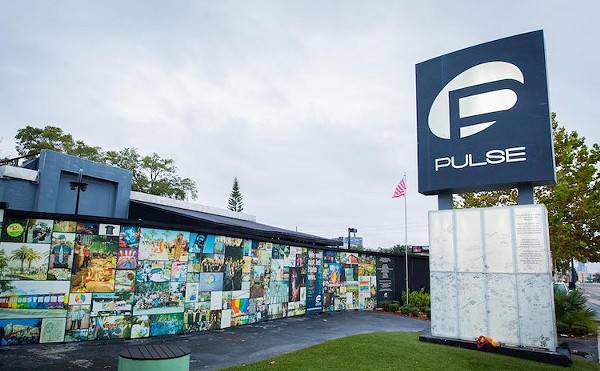‘No Trespassing: This area is a designated construction site. Anyone who trespasses on this property commits a felony!" warns a sign wired to a 3-foot-high fence off Briny Deep Court near the Orlando International Airport. "Warning: Asbestos," reads another, in bold print. The fence gate, nonetheless, is half-open.
Beyond the prohibitive entrance, 37 two-story residences exist like a blight island unto themselves. Even from outside the complex, the destruction is visible: winding PVC plumbing that leads to collapsed bathroom sinks, caved-in roofs. The walls that are still standing are covered with graffiti: "Fresh Prince. I kill you!" "CRIME HILLZ!! O-D."
A slogan painted on one of the broken-down units alludes, presumably, to recent incidents of arson: "B3. The Fire Factory." In January 2008, fire officials realized that even the fire hydrants in the area had run dry, forcing the Greater Orlando Aviation Authority to swing into action and dump water on the blazes from the sky. It was as if this little part of Orlando had been completely abandoned.
In a sense, it has. When the U.S. Navy decided to shutter its Orlando training center in 1993, it left behind two sizable pieces of land within city limits: one 1,093-acre plot close to downtown, and another 840-acre area near the airport. In 2003, the former became the cookie-cutter developer's paradise we now call Baldwin Park; the latter has yet to realize any potential at all. Some of the area's standing military housing was immediately refashioned into the Villages of Southport, a residential community, before the first foundations were poured in Baldwin Park. But other parts, like the apartment complex crumbling near the airport, still sit on the city's books, growing weeds and costs as the redevelopment market continues its nosedive.
The contrast between the two is striking, and it speaks to the way development gets done in this city: Wealthy or promising areas get attention, while poor or undesirable areas languish. Witness the same dynamic at work in the contrast between Thornton Park and Parramore.
The city has made it clear with Baldwin Park — and, more recently, with the events center — that given the right number of wealthy developers and a sense of political urgency, it can get anything done, red tape notwithstanding.
Now, after more than three years of municipal bumbling, the crumbling apartments at Southport are about to be razed. The cost to get the job done has risen from $150,000 in October 2006 to more than $850,000 today. But the city's vision for the remaining 278 acres of land in the Southport region is fuzzy. Without the political drive of former mayor Glenda Hood and her billionaire development connections that put Baldwin Park on the fast track, Southport simply rots, even though the city has long had plans to do something about the place.
"It has always been our objective," says senior city planner Bruce Hossfield, "to have redevelopment in Southport be every bit as successful as it has been with Baldwin Park."
"It has always been our objective," says senior city planner Bruce Hossfield, "to have redevelopment in Southport be every bit as successful as it has been with Baldwin Park."
The military began its residency in Orlando following World War II with McCoy Air Force Base. When that base closed in 1971, the air traffic infrastructure was bequeathed to the city of Orlando and transformed into what became the Orlando International Airport. The remaining 840 acres — primarily used for personnel support and military housing — were absorbed into the city's main Naval Training Center, which opened in 1968 and was located just south of Winter Park and east of downtown Orlando. The Naval Training Center, at its peak, housed some 650,000 sailors-in-training, creating jobs for the area. It was a symbol of national importance for pre-Disney Central Florida.
When word started circulating of the base's potential closure in the late 1980s, then-mayor Bill Frederick lobbied against it until finally, in 1993, the Federal Base Realignment and Closure Commission dropped the hammer. What happened after that is the stuff of Orlando political legend.
Frederick's successor, Hood, put on her big development hat after taking office in 1992 and got to work creating Baldwin Park on the land. The Navy didn't make the process of ceding the property easy, forcing nearly six years of hard-nosed negotiations that included a federal law forcing consideration of the homeless. In the end, on Oct. 27, 1999, the city got the base, and immediately sold it to Orlando Partners NTC, a development group that listed none other than Bill Frederick as a stockholder and director. The transaction only cost Orlando Partners $7.6 million; $4.1 million went to the Navy, $3.5 million went to the homeless groups, and the city got nothing more than the potential property taxes and a trophy for Hood's legacy.
Orlando Partners was financially backed by the Hyatt-owning Pritzker family — led by billionaire heiress Penny Pritzker, who was shortlisted in 2008 for the job of President Obama's commerce secretary — until the Pritzkers bought out the entire partnership in 2000. Critics derided the city's dealings with the Pritzkers; the Sentinel reported at the time that the city had advanced nearly $20 million to the family just to get Baldwin Park built, plus millions more to establish infrastructure. The Orlando Utilities Commission used rate increases to construct water facilities in the area.
By 2007, all of the backroom deals that led to the development of Baldwin Park were forgotten. The mixed-use development won awards from the National Association of Home Builders, the U.S. Environmental Protection Agency and the Congress for New Urbanism. Its cottages and bungalows, condos and mini-mansions, although pricey, were a vast improvement on the giant mountain of dirt that used to sit at the corner of Bennett Road and Corrine Drive. Moreover, Baldwin Park is now looked upon as a model for environmental remediation. Pieces of the old, run-down buildings were recycled after demolition and used for streets and piping. In 2006, Baldwin Park was named one of the top two revitalization projects in the country.
"This project is truly an economic revitalization success story of how unused land can be dramatically transformed into an environmentally sensitive community where thousands of people live and work," said Baldwin Park Development Company's former managing director, David Pace, in a press release for one of the groups contracted to do the redevelopment.
Pace's company, New Broad Street Co., purchased the development from the Pritzkers in Nov. 2007. The amount they paid was kept secret.
The situation at Southport isn't nearly so idyllic. The property has no high-profile boosters, and there's no chatter about new urbanism. Much of that is due to timing; construction has tanked both here and nationally. But the city says the lag is also because the Navy is responsible for its own environmental cleanup on properties it turns over, and Baldwin Park's parcel was all turned over at once. In Southport, remediation has happened piecemeal.
"Whereas at the main base they accomplished that cleanup — there's a few little holes in the piece of Swiss cheese up there, but we made one single turnover agreement with the Navy for the whole main base property," says Hossfield, the city planner. "At Southport, the Navy's cleanup didn't happen that way. It proceeded more slowly in some phases. Some of the environmental cleanup was more difficult at Southport, so the Navy tended to turn over the property at Southport in bits and pieces."
Southport actually came first in terms of dealing with the abandoned Naval Training Center property. The city formed the NTC community redevelopment agency in the summer of 1996, and set forth soliciting bids from developers to make what was then known as "Capehart Housing" into 660 salable houses and duplexes. The renovations began in 1998, and by early 2000, all of those homes were sold. The Villages of Southport neighborhood was an instant success. But plans to utilize another 173 acres of the property as freight warehouse space for the Greater Orlando Aviation Authority fell through in 2000.
The city was able to go forward with its plans for a community park.
"The next piece of property that was turned over to the city was what's now become the Southport `Community` Park, which is about 50 acres, so it's a very good-sized city park," says Hossfield. "And that came through a Department of the Interior conveyance so that it could be turned over to the city at no cost, with a deed restriction that keeps it a park in perpetuity."
For the remaining 278 acres of land, where the ramshackle apartments now stand, the city set about devising a plan, one that exhibits the same kind of "live, work, play" ethos as its sister development. But it has been plagued by problems from the start.
"The original vision plan was actually published in September 2001," says Hossfield, "and actually came back from the printer on Sept. 10, 2001, which explains why it was quite a few months before anybody was able to focus on it."
In 2006, a new plan was devised, retaining most of the same commercial, office and residential themes that were present in the original. Also in 2006, the city decided it was time to finally get rid of those 37 blighted apartments. That October, city council approved contracts for three different demolition companies, at least one of which estimated that he could take care of the project for just $150,000.
"That contractor eventually died," says District 1 commissioner Phil Diamond. "Herb Walker `of H.B. Walker, Inc.`, he died."
Two years later, on Aug. 4, 2008, the demolition was approved by city council at a cost of $400,000, an amount "necessitated by an unusually high number of building demolitions related to the event center site and the McCoy Annex/Southport properties," according to city documents. The price had more than doubled in two years because contractors were busy with other city work.
But even that wasn't the final price. On Dec. 14, city council approved a deal with Central Environmental Services in the amount of $848,250. The base demolition would be $433,550, while dealing with the asbestos in the old apartments — something Diamond says that nobody was aware of, despite the age of the construction — would almost double it. Diamond's been vocal about his frustration at the slow progress of the demolition, speaking about it at city council each it time it appears on the consent agenda.
"There have been a number of bad events that have forced that to be postponed," he says. "In addition to trying to find the funding to get this done, we also talked to the Army, because the Army has a reserve station near there. We talked with them about taking it down as part of their training exercises, because that's something the military does around the world. That proposal didn't get a lot of traction with the Army."
Diamond says he's also tried to get the Navy to take on the job.
"It's very remote and that's another reason that I felt that it needs to come down as soon as possible," he says. "Admittedly, the city may spend money that should be spent by the Navy, but I just think that it's important to take those apartments down. I think nothing good will happen there. It's something that needs to happen right away, and I've been very frustrated that it hasn't happened right away."
Diamond fields calls from Southport residents who had hoped that the area might grow to include more amenities, residents who presently have to drive out of their way just to visit a grocery store. The commissioner is also clinging to the idea of a Baldwin Park—like mixed-use development, suggesting that the property is perfectly suited for it.
The fact that the apartment buildings remain makes the property a tough sell, though, according to Diamond, and is no help to surrounding property values. At present, the city is only paying to mow the grass in the area quarterly.
Unfazed, the city sent out a request for information from potential developers able to handle large-scale redevelopment in July 2007. The request was met with "adequate but weak" response, says Hossfield; only three companies bit. On Feb. 29, 2008, the city issued a memo halting the next stage in the process, a request for proposals, for six months. It hasn't been readdressed since. It's not the right time, they say.
"The vision plan itself is not on hold," says Hossfield. "It was our vision then. It's our vision now."
Were the city able to unload the 278 acres of land, it could actually make money this time. For the first $10 million that the city gets from brokering the property, it would pocket 25 percent and the Navy would get the remaining 75 percent. However, because of the Baldwin Park sale — which the city puts at $5.4 million — applying toward that $10 million ceiling (regardless of the fact that the city didn't actually make that money), any amount the city is able to gain above and beyond the remaining $4.6 million nets 40 percent, with the Navy getting 60 percent.
"This has, I would say, turned out to be the best of the options that we have, because we want this to be a success," says Hossfield. "If we had selected a developer and turned the property over to a developer at that time — especially knowing what we know — we know that the worst thing that could have happened would have been for us to turn that property over to a developer and then have that developer go out of business, or have the whole property be foreclosed on. Then that property truly would be sitting there going to seed."
Exactly what is happening now.
Exactly what is happening now.
[email protected]

















